Colourising the 1966 World Cup has brought new life to the glorious game
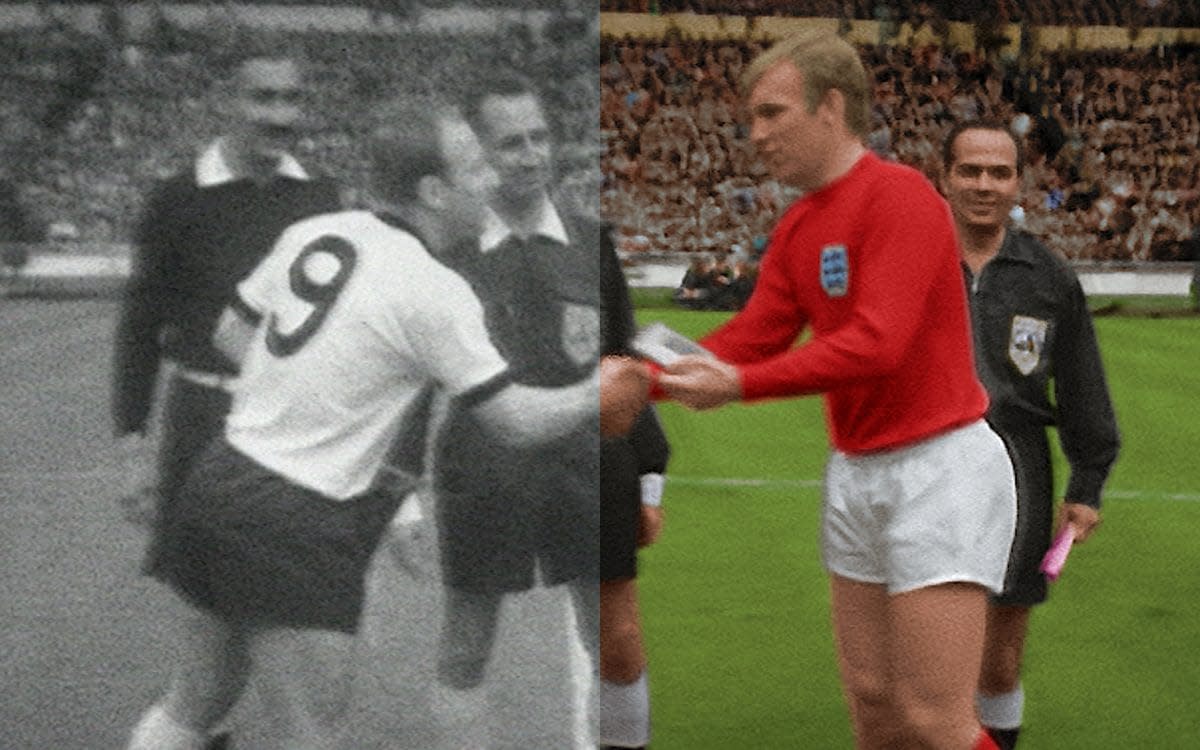
If you thought the summer of football was all over now the Olympics have replaced Euro 2020 as the nation’s preferred fix of sporting pride, then think again. As we mark, today, the 55th anniversary of English soccer’s finest hour, the first-ever full-length colour version of 1966 World Cup Final is being released in the hope of setting our patriotic pulses racing.
It uses the original black and white footage shot in the old Wembley Stadium as Germany were beaten 4-2 after extra time (as if I need to remind you of the score). But the same 200,000 frames that were broadcast live to a record audience of 32.3 million – never since surpassed – squinting at tiny grainy monochrome television screens in front rooms and pubs up and down the country have now been resurrected in full and glorious technicolour.
An eight-month, £300,000 project to rescue them from limbo in vaults where they had been gathering dust for half a century has seen them lovingly infused with colour thanks to state-of-the-art tech facilities in New Zealand, Los Angeles, India and London. The result, according to our hat-trick hero on that never-to-be-forgotten day, Geoff – now Sir Geoff – Hurst, is akin to a revelation.
“There are so many emotions. It is amazing for me to see the match again in colour. It almost feels like I am back in action at Wembley with my team-mates in front of that huge Wembley crowd,” he says.
Indeed 79-year-old Sir Geoff likes it so much that he has agreed to sign 1,966 limited edition copies of the DVD, which goes on sale today. What makes it even more poignant is that seven of the original 11-man starting line-up brought back to life in the film are no longer with us.
This week is the 55th anniversary of the 1966 World Cup Final – one of the 'Greatest Ever” football matches. Our remastered film is out now. In full colour - https://t.co/aqyEdJ696K
In support of @alzheimerssoc #Football #fullcolour66 @TheGeoffHurst pic.twitter.com/N4SA4hdr2S— Final Replay (@FinalReplayTV) July 28, 2021
Four of them – Jack Charlton, Ray Wilson, Nobby Stiles and Martin Peters – suffered from dementia in the years before their deaths, while one of the survivors, Sir Bobby Charlton, 83, has also been diagnosed with it. Part of the proceeds of the DVD sales will go to support Alzheimer’s Society’s Sport United Against Dementia campaign.
The project is the labour of love of former ITV finance director Neil Canetty-Clarke, through his Sussex-based production company, Final Replay. It all began, he explains, in May 2020 when, having managed to retrieve the original footage of the 1966 final, he arranged for it to be shown during lockdown in black and white on Channel 4 one Sunday afternoon as part of an initiative to raise £600,000 for the National Emergencies Trust, the domestic disasters charity chaired by Lord Dannatt.
“What took us by surprise at the time was how successful it was,” he recalls. “It went viral on Twitter and was the number one trending topic. Lots of people were asking, ‘can we see it in colour?’, which set me off on what became both a hunt and a race against time in order to have it ready for this 55th anniversary.”
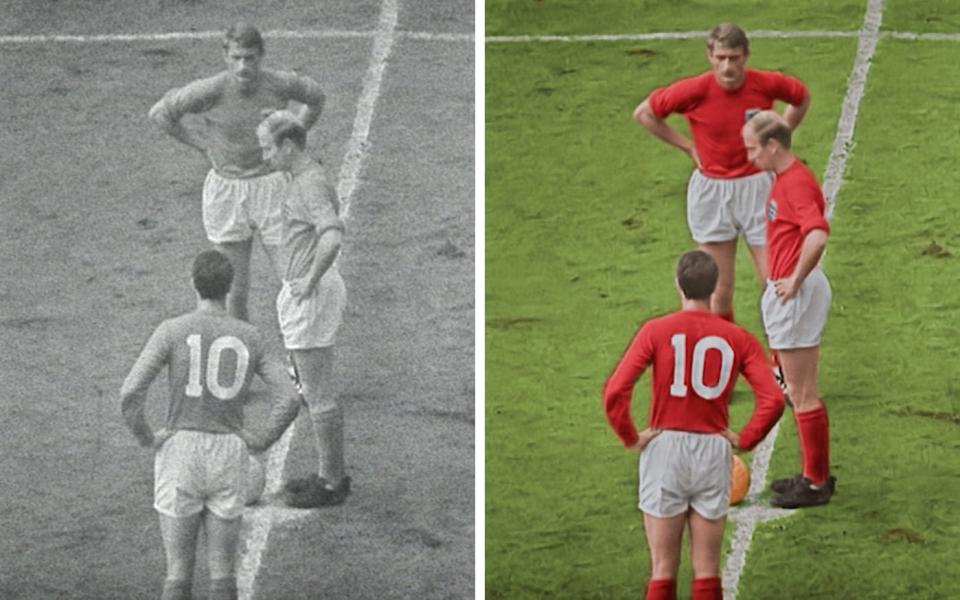
Though in 1966 he had been too young to watch, or even be aware that a World Cup Final was taking place – “my dad was keener on wrestling and boxing” – 59-year-old Canetty-Clarke found out, via his friend, Greg Dyke, former Football Association chairman and ex director-general of the BBC, that some short sequences in colour from the match did exist.
They had been aired on ITV in 1986 in The Boys of ’66, narrated by Sir Michael Parkinson. No one, though, knew what had happened to the whole original colour recording of the final from which those sections had been taken. Even the FIFA archivist in Geneva couldn’t find a trace after ransacking its archives.
The whole thing was turning into a needle in a haystack search to find a lost reel of old film forgotten in someone’s garage or attic, when the roll of the ball finally went Canetty-Clarke’s way. He managed to get in touch with the South African film-maker, Ross Devenish, now in his 80s and living in retirement in Cape Town.
In 1966, he had been part of the team in England making an artsy 90-minute cinema film, GOAL!, about the whole World Cup tournament. Devenish was able to confirm that the short clips in Parky’s show were from GOAL!
They were just a fraction of the 46 hours of colour footage they had shot during the entire tournament on state-of-the-art 35mm film. So far so good, but then came what felt like a final blow to Canetty-Clarke’s hopes: it had all been edited down to just 10 minutes to include in the final film.
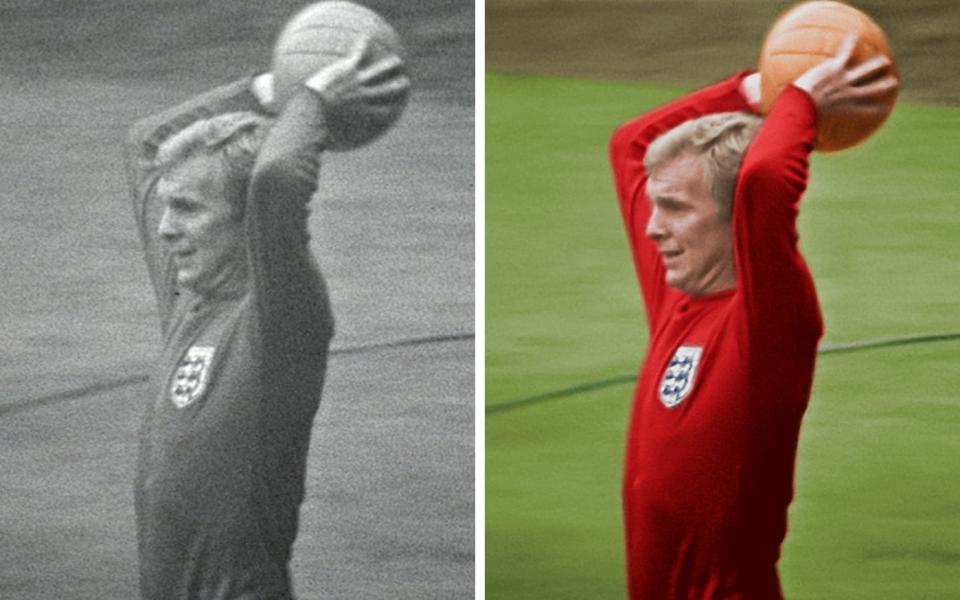
What hadn’t been used, Devenish reported, had ended up on the cutting room floor and then most likely had been recycled, 35mm film containing expensive and rare silver nitrate. It looked like it wasn’t coming home after all.
But then Canetty-Clarke remembered seeing 2018’s They Shall Not Grow Old. “It is an incredible, painstakingly-restored First World War film, using original black and white archive footage that had been colourised. If I couldn’t find the colour original of the final, I thought, why not restore and colourise the black and white version?”
They Shall Not Grow Old had been made by Park Road Post Production in the New Zealand capital, Wellington, run by Sir Peter Jackson, director of The Lord of the Rings and The Hobbit. It agreed to come on board with Canetty-Clarke’s project.
“It took a month, partly done by hand and partly by machines. The result was great. All the dirt and scratches and fussiness had gone. It was sharp with depth and contrast once again,” he explains.
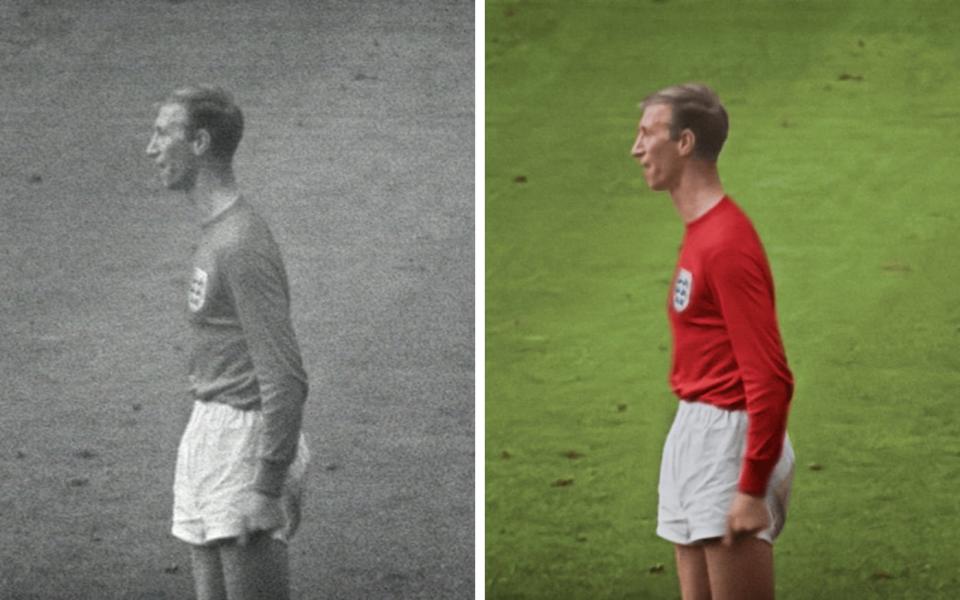
There was, though, one final problem. The software was programmed to spot “hairs on the gate” – marks or smudges on the film – and automatically delete them. But in places it had decided to treat the match ball as a mark.
“So you ended up seeing Geoff Hurst fire the ball towards the top of the Germans’ goal, then it disappeared in mid-flight and only reappeared when it was in the back of the net. It was like playing Spot the Ball,” says Canetty-Clarke.
Once that glitch had been sorted, the process moved across the Pacific to Los Angeles and pioneers in colourisation, West Wing Studios. They assembled a colour design for every detail in the 130-minute black and white film, using old colour photographs and posters from 1966 as well as archive materials from the National Football Museum in Manchester, so as to get the exact shades right.
“Particularly tricky,” says Canetty-Clarke, “was the striking yellow hat and coat the Queen was wearing to present the trophy, and getting the right red for Nobby Stiles’s socks, especially when they concertinaed down his legs during extra time. But the one that caused me a last minute panic was when I suddenly realised quite how ginger [midfield maestro] Alan Ball’s hair was. We had made it a dull brown.”
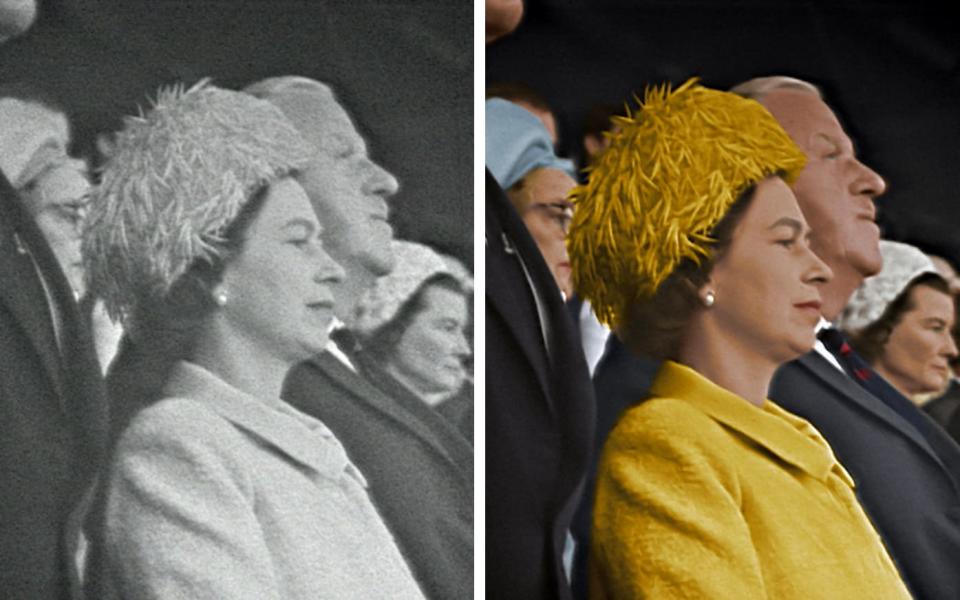
The work of adding the colour, frame by painstaking frame, was done by a team of 50 experts working in a studio in Goa, India. When a final print was ready, Canetty-Clarke tested it out against the recollections of Ross Devenish, who had been there on the day.
“Seeing it,” the veteran South African says, “brought the past back to the present. It was a memory suddenly coming to life. I was young again, just as I had been when I saw it before my own eyes 55 years ago.”
As well as the emotion of it, Devenish feels that adding colour to the black and white print has brought the 1966 final bang up to date. “What struck me strongly was that for people watching today, the restoration gives the match an immediacy, as if it is not history but it is here and now.”
So much so, Canetty-Clarke suggests, that it can challenge our collective memory of the match. While the traditional hero figures in accounts of the game these past 55 years have been Hurst and captain Bobby Moore, among younger viewers of the restored film – who had never seen the match before – Alan Ball was repeatedly picked out as the most influential member of the team.
If some things are gained, others that have achieved almost mythical status since have been lost. When the final colour version was ready, a soundtrack had to be added. Both BBC and ITV had broadcast it live on the day, but in the end Canetty-Clarke went with ITV and Hugh Johns as commentator rather than the BBC’s Kenneth Wolstenholme.
So the deciding goal is accompanied by Johns’s “Geoff Hurst goes forward, and he might make it three. He has! He has! And that’s it. That’s it.” It takes the place usually reserved for Wolstenholme’s much more familiar: “They think it is all over! It is now.”
The first broadcast of the restored full-colour version was shown on Channel 4 earlier this month in the build-up to England’s attempt, at the Euros, to win their first major trophy since. It wasn’t to be. But perhaps if Gareth Southgate’s team uses the DVD in training, they might just match the vivid spirit of the 1966 lions at the World Cup in Qatar next year.

 Yahoo News
Yahoo News 
